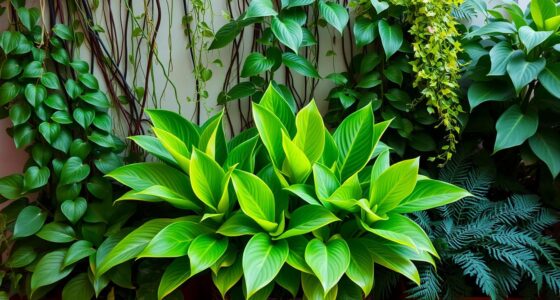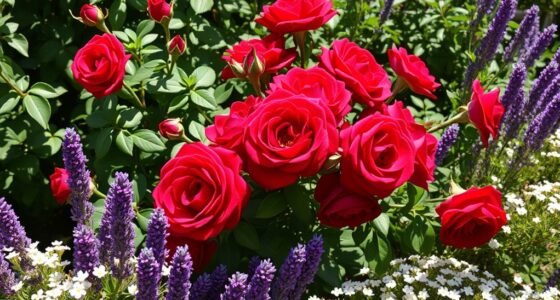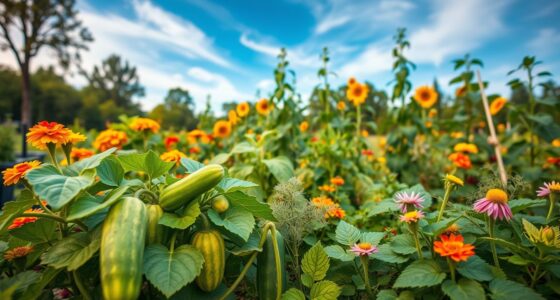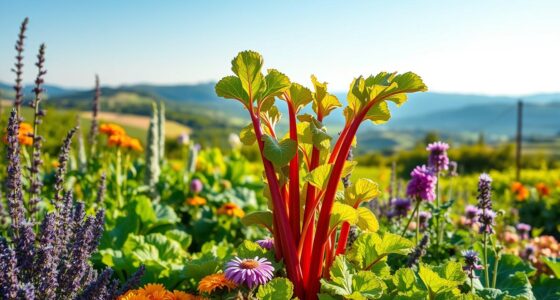Have you ever wandered into your garden and marveled at the vibrant green leaves of your collard greens? These leafy gems are not just a source of nourishment; they invite you into the rich tapestry of nature’s partnerships. Just like friendships that enrich our lives, choosing the right collard greens companion plants enhances their growth, flavor, and resilience. Imagine stepping into your garden and not only seeing healthy greens but also experiencing an ecosystem that thrives around them. It’s astonishing how a bit of planning and understanding can transform your garden into a flourishing community.
Diving into the world of companion planting can be exhilarating. The best companion plants for collard greens don’t just coexist; they work together to create a vibrant, healthy environment that benefits every plant involved. Throughout this article, you’ll discover the finest allies for your collard greens, ensuring you cultivate a garden that is not only productive but also a source of joy and pride.
Key Takeaways
- Collard greens thrive with the right companion plants, enhancing their growth and flavor.
- Understanding the needs of collard greens is crucial for effective companion planting.
- Choosing beneficial plants helps in pest control and nutrient sharing.
- A well-planned garden can create a thriving ecosystem for your plants.
- Optimal companion planting can yield greater harvests and healthier crops.
Understanding Collard Greens’ Needs
To cultivate healthy and robust collard greens, you must first understand their specific needs concerning soil, sunlight, water, and temperature. By providing the right conditions, you ensure that these plants thrive alongside their collard greens planting companions and maximize their potential.
Soil Requirements for Healthy Growth
Collard greens flourish in well-drained, nutrient-rich soil. A soil pH between 6.0 and 6.8 supports optimal growth. Enriching the soil with organic matter helps enhance fertility, making it an excellent environment for your collard greens garden companions. To achieve the best results, incorporate compost or well-rotted manure and ensure the soil is loose and aerated.
Sunlight and Water Needs
These leafy greens require full sun, ideally receiving at least six hours of sunlight daily. Consistent moisture is essential, though be cautious of overwatering, as collard greens dislike soggy soil. It’s critical to find that balance to promote vigorous growth while avoiding issues related to excess moisture. A routine watering schedule will benefit your greens tremendously.
Ideal Temperature for Optimal Growth
Collard greens perform best in cooler temperatures, typically between 60°F and 70°F. As a cool-season crop, they thrive with proper care during these conditions, making them a popular choice in spring and fall gardens. Monitoring the temperature can help you plan your planting schedules effectively.
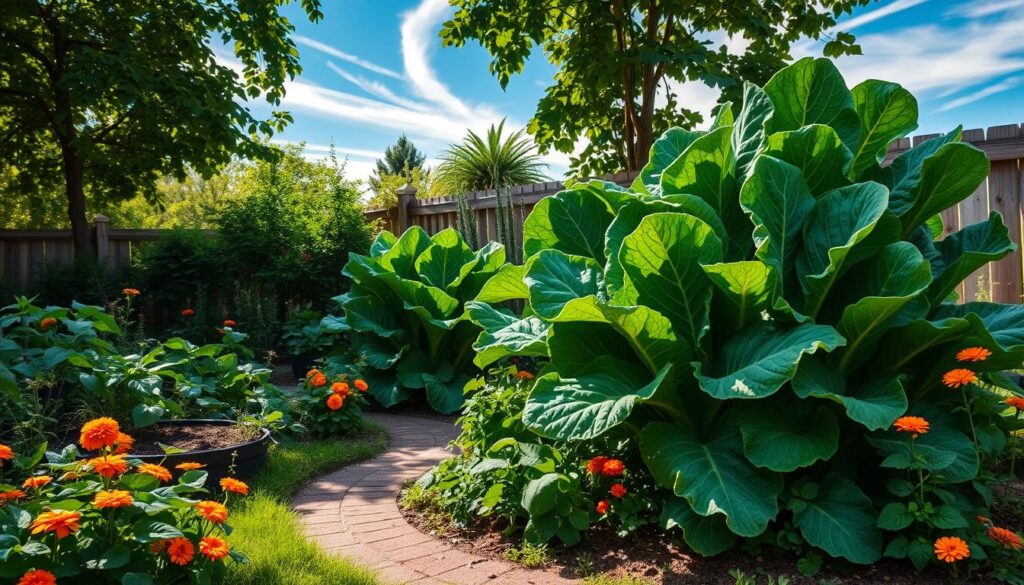
| Growth Factor | Optimal Condition |
|---|---|
| Soil Type | Well-drained, nutrient-rich |
| pH Level | 6.0 – 6.8 |
| Sunlight | At least 6 hours daily |
| Watering | Consistent moisture, avoid soggy soil |
| Ideal Temperature | 60°F – 70°F |
Best Companion Plants for Collard Greens
Companion planting with collard greens opens a world of benefits for your garden. Selecting the right plants can enhance growth while supporting each other through various biological interactions. This section explores the best companions for collard greens based on their nitrogen-fixing abilities, flavor enhancement, and pest control properties.
Legumes for Nitrogen Fixation
Legumes such as bush beans are remarkable companions for collard greens. These plants have the unique ability to fix nitrogen in the soil, an essential nutrient that collard greens crave. As a result, planting these legumes alongside collard greens can lead to healthier plants and a more bountiful harvest. Reference your collard greens companion planting chart to determine the optimal planting patterns for maximum benefits.
Aromatic Herbs to Enhance Flavor
Aromatic herbs, like dill and cilantro, not only add flavor to your meals but also attract beneficial insects to your garden. These insects pollinate your crops and help control pests that might harm your collard greens. Growing these herbs nearby can create a friendly ecosystem, boosting the overall health of your garden.
Cruciferous Companions and Pest Control
Other cruciferous vegetables, including kale and broccoli, serve as excellent companions for collard greens. These plants not only thrive in similar growing conditions but also work together in natural pest control. By safeguarding one another from common garden pests, they strengthen each other’s resilience. Combining these vegetables can significantly enhance your garden’s productivity.
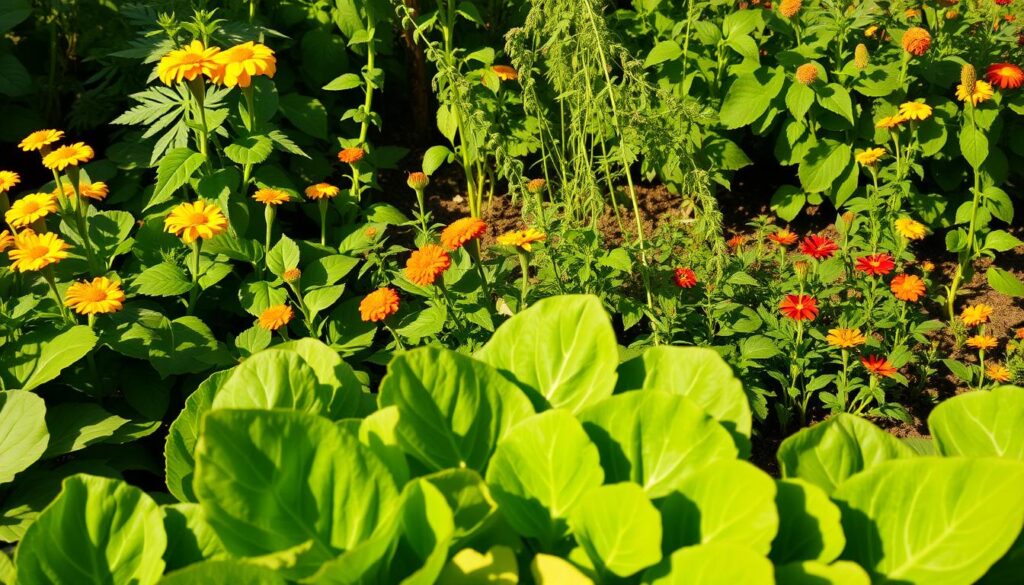
Plants to Avoid Near Collard Greens
When cultivating collard greens, it’s essential to consider the surrounding plants in your garden. Understanding which plants to avoid with collard greens can help ensure a healthier and more productive crop. Some plants can harm your collard greens through pest attraction, resource competition, or nutrient depletion.
Why Nightshades Don’t Mix
Nightshade plants, including tomatoes, peppers, and eggplants, can harbor pests and diseases detrimental to collard greens. These pests tend to spread quickly, affecting your entire garden. It’s best to keep these plants at a distance to protect the health of your collard greens.
The Negative Impact of Strong Aromatics
Strong aromatic plants like garlic may seem beneficial at first. Their distinctive scents can deter some pests. However, they often compete vigorously for resources such as water and nutrients. This competition can disrupt the balance necessary for your collard greens to thrive.
Competing Crops that Hog Nutrients
Avoid planting crops like corn and potatoes near collard greens. These plants are known to consume significant nutrients from the soil, leaving little for your collard greens. By choosing wisely, you can maintain a healthy growth environment free from the plants to avoid with collard greens.
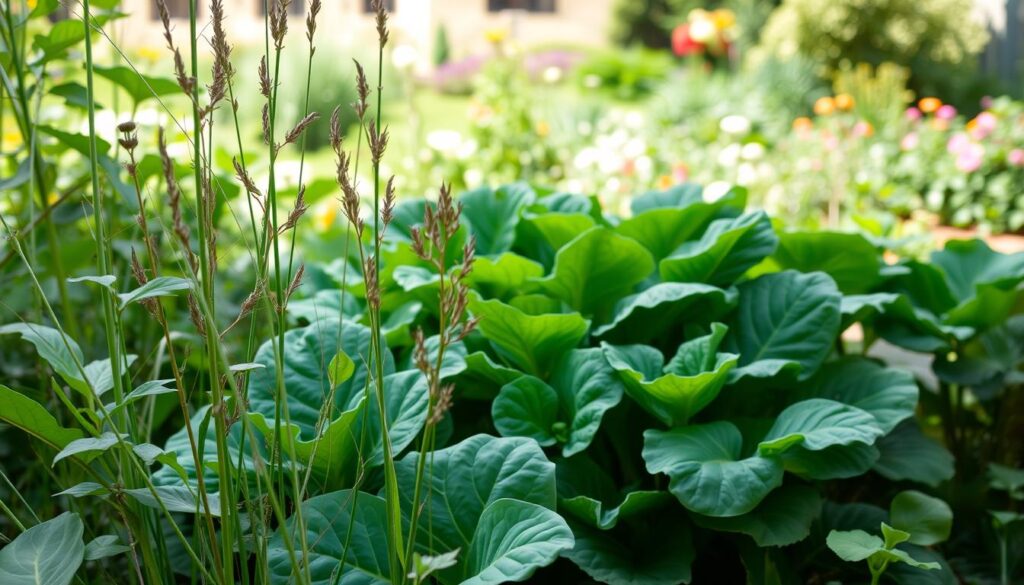
Planting Strategies for Companion Plants
Implementing effective planting strategies is essential in the collard greens companion planting guide. Understanding how to utilize layering, spacing, and seasonal placement can significantly elevate the success of your garden. Here’s how to cultivate a thriving ecosystem around your collard greens.
Layering and Spacing Techniques
Proper spacing is vital for the health of your collard greens. Aim for 18 to 24 inches between each plant. This distance not only allows for air circulation but also ensures ample sunlight exposure. Consider layering techniques, which help you take advantage of vertical space. Taller plants can provide shade for fragile seedlings, creating an optimal environment for growth.
Companion Plant Placement by Season
Timing your companion planting matters greatly. Plan your collard greens companion planting guide carefully to avoid competition for nutrients and light during critical growth phases. Certain companion plants flourish during specific seasons, so placing them according to their ideal growing conditions can enhance overall yield. Use a rotation schedule to maximize your garden’s potential.
Companion Planting in Raised Beds
Raised beds offer several advantages for successful gardening. They facilitate better drainage and soil management, which support healthy growth for collard greens and their companions. With this setup, you can easily nurture a balanced ecosystem that encourages robust plant health. Choose companion plants that harmonize well with collard greens and thrive in the raised bed environment.
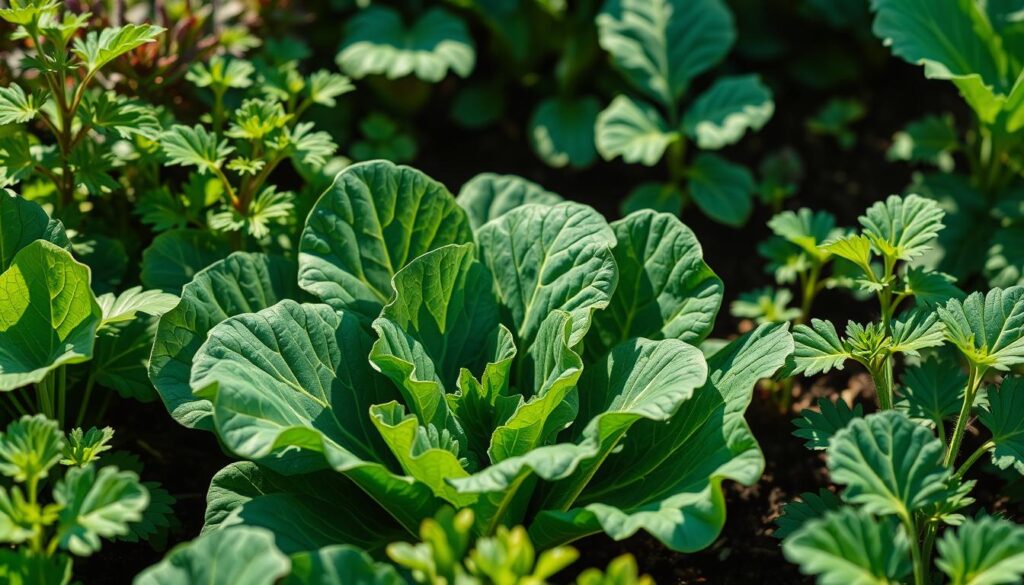
Benefits of Companion Planting with Collard Greens
Companion planting offers numerous advantages when growing collard greens. By strategically selecting plant partners, you can achieve better pest management, improved growth rates, and enhanced disease resistance. Explore these collard greens companion planting benefits to create a thriving garden.
Improved Pest Management
Integrating various plants alongside collard greens can attract beneficial insects that prey on common pests. These natural allies contribute to a balanced ecosystem, reducing the reliance on chemical pesticides. The presence of flowering companions may deter harmful insects, allowing your collard greens to flourish.
Enhanced Growth and Yields
When collard greens grow alongside compatible companions, they can share resources and nutrients more effectively. This synergy often results in higher growth rates and improved yields. The combination of different root systems can promote healthier soil and optimal moisture retention, ultimately benefiting all plants involved.
Natural Tolerance to Diseases
Diversity in plant arrangements tends to build resilience against diseases that affect collard greens. Companion plants can act as barriers or signal distress to collards, triggering defense mechanisms against pathogens. This mutual support fosters a sustainable garden environment, enhancing the overall health of your plants.
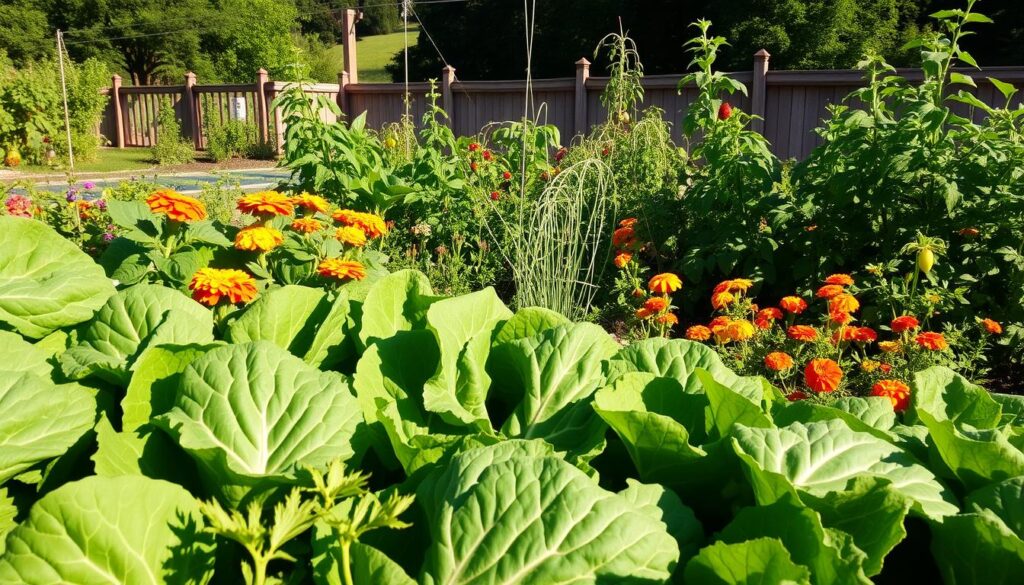
| Benefit | Description |
|---|---|
| Improved Pest Management | Attracts beneficial insects while repelling harmful ones. |
| Enhanced Growth and Yields | Promotes resource sharing, leading to higher productivity. |
| Natural Tolerance to Diseases | Builds resilience against common diseases affecting collard greens. |
Attracting Beneficial Insects
Attracting beneficial insects for collard greens plays a crucial role in creating a thriving garden ecosystem. By inviting these helpful creatures into your space, you can improve pollination, pest management, and overall biodiversity. Below are ways to encourage these insects and enhance your gardening experience.
Pollinators to Boost Your Garden
Pollinators, including bees and butterflies, are essential for many flowering plants in your garden. These insects help in cross-pollination, leading to improved yields of your collard greens and other companion plants. To attract pollinators, consider planting flowering herbs such as lavender, borage, and thyme. A variety of colors and shapes in flowering plants can entice more pollinators to your garden at different times.
Predators for Pest Control
Incorporating predatory insects can significantly decrease pest populations that harm your collard greens. Ladybugs and lacewings are known to feed on aphids and other harmful pests. Planting flowers like yarrow and dill can attract these beneficial predators, creating a natural balance in your garden. Maintaining an environment where these insects thrive helps ensure your collard greens remain healthy and pest-free.
Encouraging Biodiversity Nearby
Creating a diverse environment benefits beneficial insects for collard greens. A mixture of flowering plants, shrubs, and even small trees can foster a habitat for various insects. This biodiversity encourages a stable ecosystem, allowing plants to thrive naturally. The result is a healthier garden that supports your collard greens and enhances the overall productivity of your space.
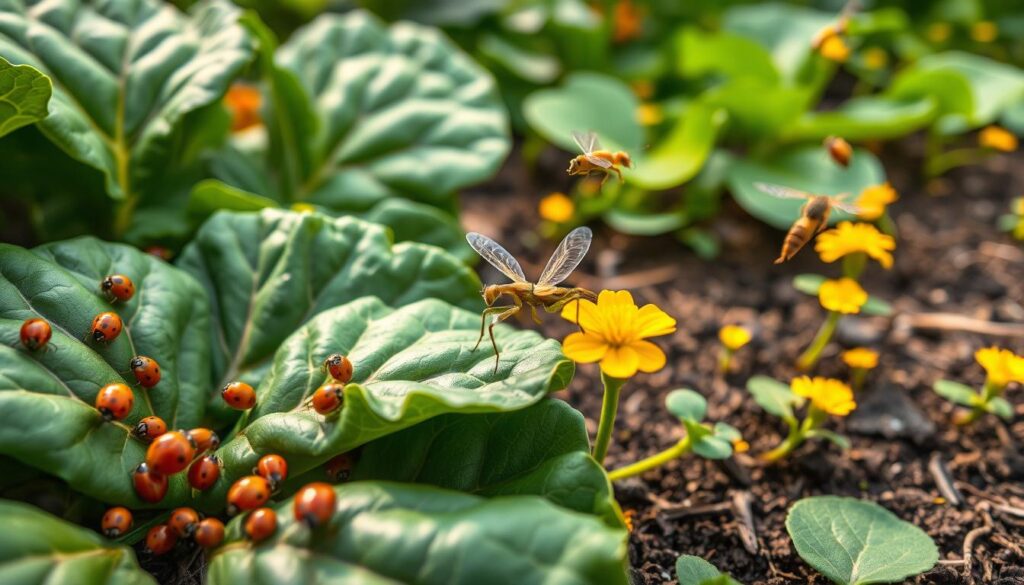
Using Flowers as Companion Plants
Flowers can serve as essential companions for collard greens, enhancing both the aesthetic appeal of your garden and its overall health. By integrating flower companions for collard greens, you can naturally deter pests, attract beneficial insects, and create a thriving ecosystem.
Marigolds to Deter Pests
Marigolds are one of the most effective flower companions for collard greens. Their distinctive fragrance not only adds vibrant color to your garden but also acts as a natural deterrent for various pests. Planting marigolds around collard greens can help repel aphids, nematodes, and other harmful insects, allowing your greens to flourish.
Nasturtiums as a Tasty Trap Crop
Nasturtiums are another fantastic choice as flower companions for collard greens. These edible flowers can be used as trap crops, attracting aphids and other damaging insects away from your collards. By diverting pests, nasturtiums protect your greens while offering a unique flavor boost to salads and dishes.
Sunflowers for Attracting Beneficials
Sunflowers add beauty and height to your garden and play a crucial role in attracting beneficial insects. By incorporating sunflowers among your collard greens, you can invite pollinators such as bees and ladybugs, which help with pest control. Not only will you enjoy their stunning appearance, but you will also contribute to a healthier garden ecosystem.
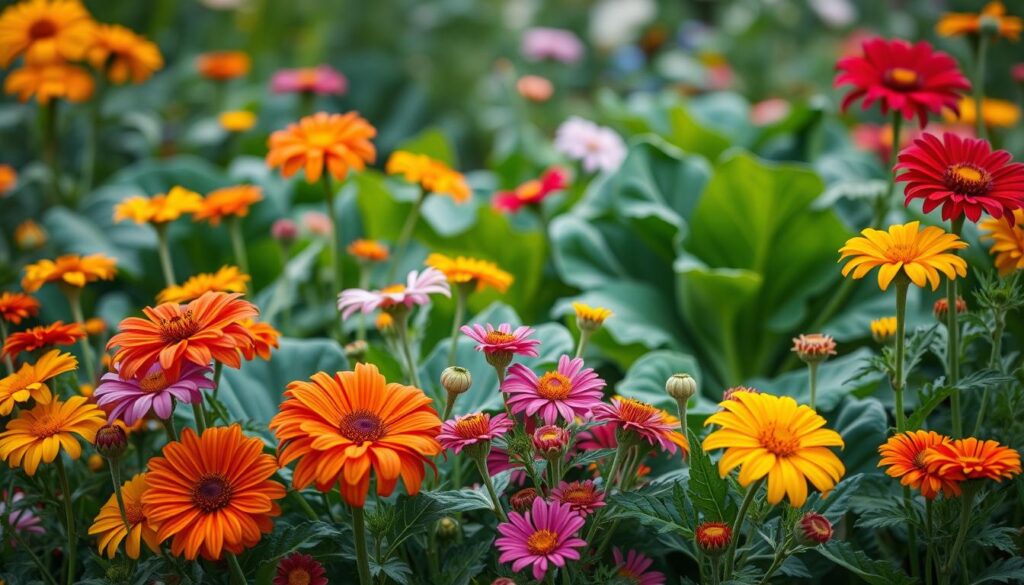
Rotating Companion Plants Seasonally
Incorporating seasonal crop rotation for collard greens can lead to a healthier garden and improved yields. This practice enhances soil health while reducing the risk of diseases. By wisely planning which plants to grow in succession, you allow your soil to replenish nutrients and maintain overall resilience.
Benefits of Crop Rotation
Utilizing seasonal crop rotation offers multiple advantages. Here are some key benefits:
- Minimizes disease risks: Rotating different plant families helps prevent disease buildup in the soil.
- Improves soil structure: Different root systems enhance soil aeration and water retention.
- Increases biodiversity: Varied planting attracts beneficial insects and promotes ecosystem health.
Recommended Rotations for Collard Greens
After collard greens, consider planting legumes such as beans or peas. These plants are excellent nitrogen fixers, replenishing essential nutrients in the soil. Here’s a simple rotation plan:
| Season | Previous Crop | Next Crop |
|---|---|---|
| Spring | Collard Greens | Legumes (Beans, Peas) |
| Summer | Legumes | Leafy Greens (Spinach, Lettuce) |
| Fall | Leafy Greens | Brassicas (Kale, Cabbage) |
Keeping Your Soil Healthy
To maintain soil vitality, practice seasonal crop rotation with collard greens. This approach not only boosts soil fertility but also disrupts pest cycles, promoting a more sustainable gardening method. Remember, healthy soil leads to healthier plants, ensuring your garden flourishes year after year.
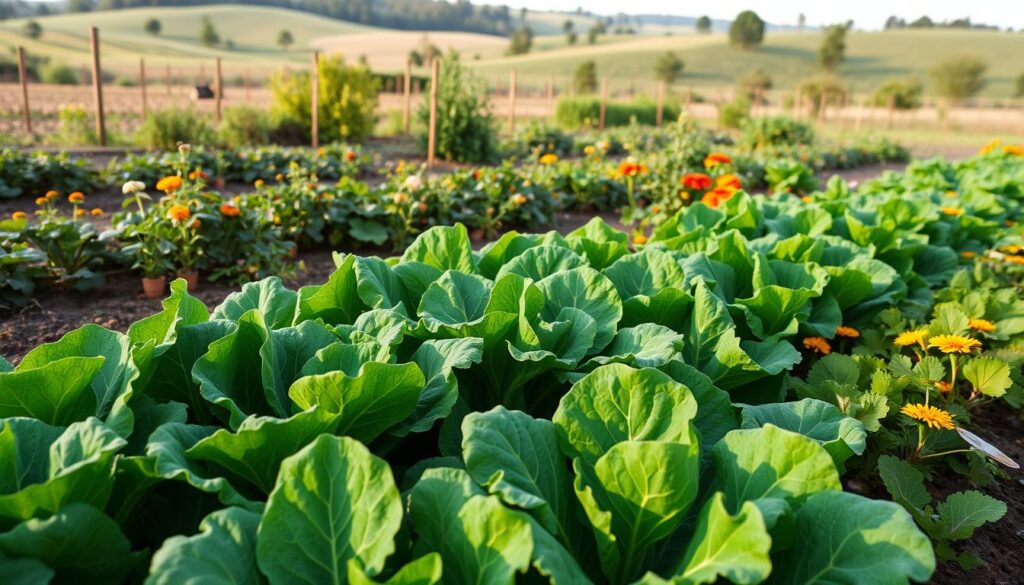
Incorporating Cover Crops
Integrating cover crops for collard greens into your gardening practice offers numerous benefits. These crops can help improve soil structure and fertility while playing a crucial role in reducing erosion and controlling weed growth. Understanding the timing and types of cover crops will further enhance your collard greens’ growth.
Improving Soil Fertility
Cover crops for collard greens, such as clover or vetch, are excellent at fixing nitrogen in the soil. This natural process enriches the soil, making it more fertile for your collard greens. By planting these crops during the off-season, you set the stage for healthier plants and larger yields come planting time.
Reducing Erosion and Weeds
Cover crops act as a protective layer over the soil, preventing erosion caused by wind and rain. Their root systems help stabilize the soil, making it less susceptible to degradation. Additionally, these crops can suppress weed growth by outcompeting undesired plants. This means a cleaner and more focused environment for your collard greens to thrive.
Timing Your Cover Crops
Knowing when to plant cover crops is vital for maximizing their benefits. Ideally, you should sow them at least a few weeks before the first frost of the year. This will allow the crops enough time to establish and positively affect your soil before you plant your collard greens. Proper timing ensures that your gardening efforts yield fruitful results.

| Cover Crop | Benefits | Ideal Timing |
|---|---|---|
| Clover | Nitrogen fixation, erosion control | Sow in late summer or early fall |
| Vetch | Nitrogen enrichment, weed suppression | Sow in late summer |
| Rye | Soil structure improvement, weed control | Sow in late summer |
Calming Collard Greens’ Pests Naturally
Maintaining a healthy crop of collard greens often involves managing pests that threaten their growth. Embracing natural pest control for collard greens can effectively reduce infestations without chemical treatments. Exploring botanical solutions and beneficial insects may enhance the health of your garden.
Botanical Solutions for Common Pests
Utilizing plant-based remedies can significantly lower common pest populations. Neem oil is a popular choice for organic gardeners, as it targets various insects while being safe for plants. Spraying neem oil on affected areas can discourage pests such as aphids and spider mites, promoting a healthier environment for your collard greens.
Beneficial Bugs and How to Attract Them
To encourage a balanced ecosystem, consider attracting beneficial insects. Ladybugs and lacewings are excellent allies, feasting on pests like aphids and caterpillars. You can draw these helpful bugs to your garden by planting flowers like dill, fennel, and yarrow, enhancing the efficacy of your natural pest control for collard greens.
Companion Plant Follies to Watch Out For
While companion planting can be advantageous, certain combinations might create unexpected issues. For instance, planting strong-scented herbs too close to collard greens may attract unwanted pests or repel beneficial insects. Observing plant interactions within your garden helps maintain a balanced ecosystem and ensures effective natural pest control for collard greens.

Harvesting and Companion Plant Care
As you approach the time for harvesting collard greens with companion plants, signs of readiness become essential for maximizing your yield. Understanding these signals and maintaining the health of your companion plants enhances your garden’s overall success.
Signals for Collard Greens Harvest
Look for mature leaves that are firm and vibrant. These indicate that your collard greens are ready for harvesting. The leaves should be a deep green color, free from blemishes. Not only does careful observation help in selecting the best greens, but it also allows you to plan your subsequent harvests efficiently.
Best Practices for Companion Plant Management
Nurturing your companion plants throughout the growing season fosters a beneficial ecosystem. Regularly check for pests and diseases, ensuring that your companions contribute positively to the garden. Proper watering, nutrient management, and timely pruning will enhance the resilience of both collard greens and their neighboring plants.
Preparing for Next Season Together
Proper soil preparation and planning for cycles of planting and harvest keeps your garden thriving. Rotate your companion plants to prevent nutrient depletion. A well-thought-out approach for planting and harvesting collard greens with companion plants assures a continuous bounty year after year.
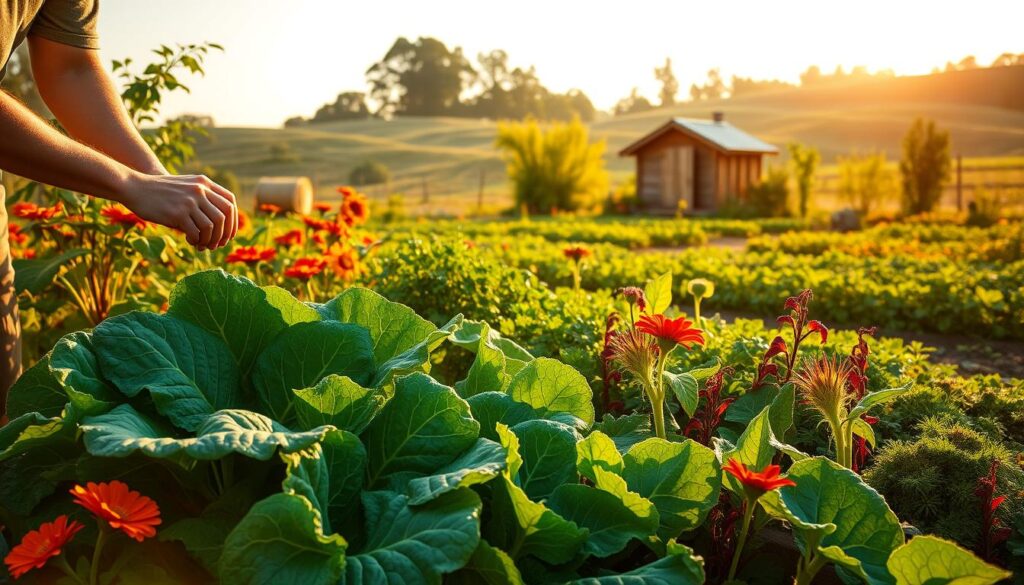
Recipes Featuring Collard Greens
Collard greens bring a hearty flavor to many dishes, especially when combined with seasoning herbs and companion vegetables from your garden. You can explore a variety of collard greens recipes with companion plants that celebrate taste and nutrition, ensuring an enjoyable culinary experience.
Delicious Dishes to Combine with Seasoning Herbs
Integrating herbs such as thyme, rosemary, and oregano can elevate your collard greens. Try sautéing your greens with crushed garlic and a sprinkle of fresh thyme for a flavorful side dish. A smooth collard greens soup with rosemary adds an aromatic twist that will impress anyone at your dinner table.
Unique Flavors from Other Companion Veggies
Enhance your meals by pairing collard greens with other companion veggies. For instance, a refreshing coleslaw made with shredded collards and carrots or a creative stir-fry incorporating bell peppers and onions will surprise your taste buds. These combinations highlight the freshness of your garden.
Healthy Ways to Enjoy Your Companion Garden
Make the most of your garden harvest by preparing wholesome meals. Prepare a light salad featuring collard greens, cucumbers, and some chickpeas, drizzled with olive oil and lemon juice. These healthy collard greens recipes with companion plants not only taste great but also support a balanced diet.
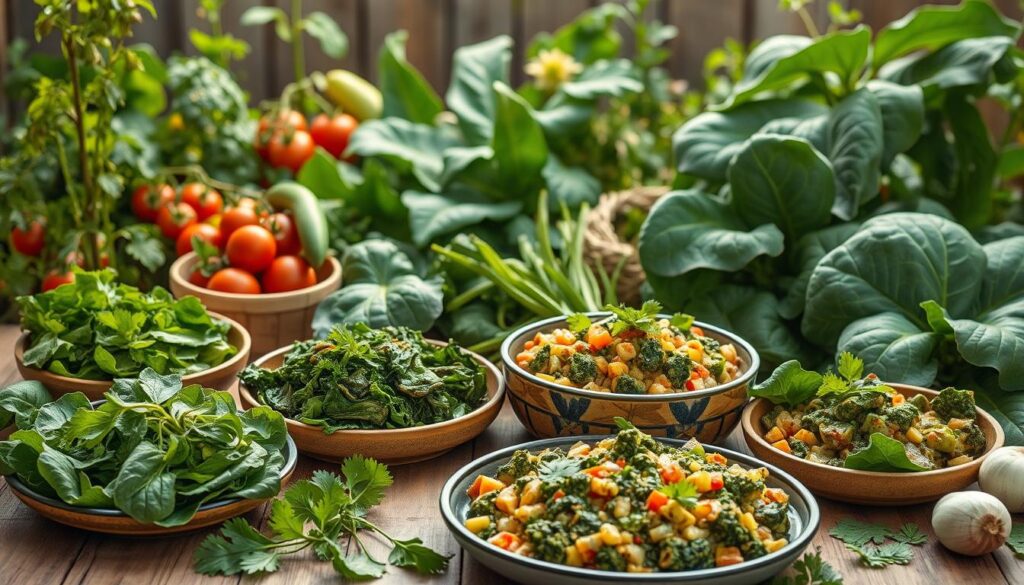
| Recipe | Main Ingredients | Preparation Method |
|---|---|---|
| Garlic Sautéed Collard Greens | Collard greens, garlic, thyme | Sauté garlic in olive oil, add collard greens and thyme. |
| Collard Greens & Carrot Coleslaw | Collard greens, carrots, apple cider vinegar | Shred collards and carrots, mix with vinegar, chill before serving. |
| Collard Greens Salad | Collard greens, cucumbers, chickpeas | Combine ingredients, drizzle with olive oil and lemon juice. |
Gardening Tools and Supplies
To successfully cultivate collard greens alongside their companions, having the right gardening tools for collard greens is essential. There’s a range of supplies that will help you manage planting, nurturing, and protecting your garden effectively.
Must-Have Tools for Companion Planting
Start with basic hand tools like trowels and weeding forks, which allow for accurate planting and weed removal. A sturdy garden rake helps to prepare the soil, while a hoe can assist in creating furrows for seed placement. Don’t overlook the value of garden gloves and kneeling pads, which can make your gardening experience more comfortable.
Soil Amendments for Optimal Growth
Soil amendments play a crucial role in the health of your collard greens. Adding compost provides essential nutrients and improves soil structure. Organic fertilizers like fish emulsion or bone meal can enhance nutrient content and support strong growth. Testing your soil’s pH can help fine-tune amendments, ensuring optimal conditions for your plants to thrive.
Pest Control Essentials You’ll Need
Organic pest control products are vital for maintaining a healthy garden. Items like neem oil and insecticidal soap can effectively manage pests without harming beneficial insects. You might also consider row covers to physically block pests while allowing sunlight and moisture through. Being equipped with these gardening tools for collard greens ensures you’re prepared for any challenges that can occur in the garden.
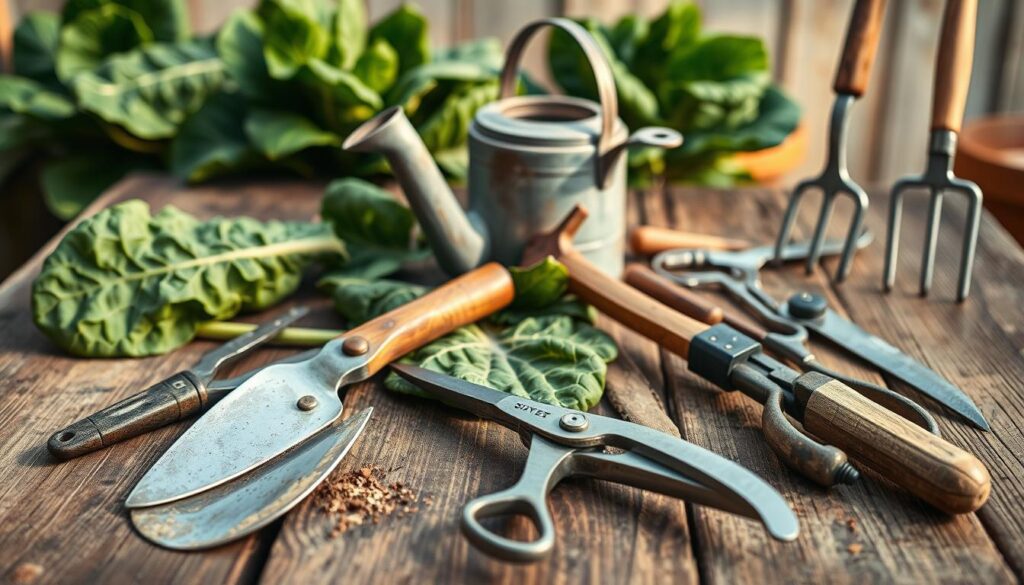
Getting the Most Out of Your Garden Space
Maximizing garden space for collard greens is essential if you’re looking to create a thriving environment for these leafy greens and their companion plants. By using innovative gardening techniques, you can increase the yield of your crops while ensuring that each plant has adequate resources for healthy growth. Let’s explore some effective strategies for making the most of every inch in your garden.
Vertical Gardening Techniques
One of the most effective ways of maximizing garden space for collard greens is through vertical gardening. Utilizing trellises for climbing plants or wall-mounted containers can save ground space and allow for a healthy airflow around your veggies. This method not only makes use of vertical areas but can also create a stunning visual aspect in your garden.
Intensive Planting for Maximum Yield
Another technique to consider is intensive planting. By closely spacing your collard greens with companion plants, you encourage a micro-ecosystem that maximizes yield while minimizing competing weeds. This method helps you make the most of your garden layout, ensuring every square foot contributes to your vegetable harvest.
Optimizing Your Layout for Success
Finally, effective layout optimization is key. Organizing your garden in a way that facilitates easy access and sunlight exposure will enhance plant health and make maintenance easier. Creating a thoughtful design not only contributes to the productivity of collard greens but also leads to a more enjoyable gardening experience.


